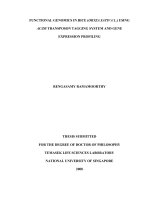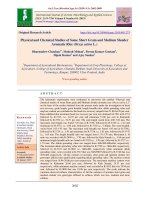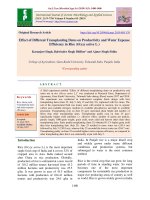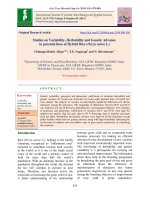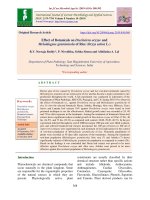Identifying drought tolerant genotypes of rice (Oryza sativa L.) using participatory research approach for resource poor farmers of Orissa
Bạn đang xem bản rút gọn của tài liệu. Xem và tải ngay bản đầy đủ của tài liệu tại đây (260.23 KB, 7 trang )
Int.J.Curr.Microbiol.App.Sci (2017) 6(7): 182-188
International Journal of Current Microbiology and Applied Sciences
ISSN: 2319-7706 Volume 6 Number 7 (2017) pp. 182-188
Journal homepage:
Original Research Article
/>
Identifying Drought Tolerant Genotypes of Rice (Oryza sativa L.) Using
Participatory Research Approach for Resource Poor Farmers of Orissa
A.K. Mall*, P. Swain and O.N. Singh
Central Rice Research Institute (CRRI), Cuttack-753 006, Orissa, India
*Corresponding author
ABSTRACT
Keywords
Rice, Yield,
DSI, DTE and
PVS.
Article Info
Accepted:
04 June 2017
Available Online:
10 July 2017
To encourage rice-rice cropping system, enhance yield and livelihood in rainfed
areas, Drought Breeding Network, Cuttack conducted “Participatory Varietal
Selection (PVS)” trial at Samian and Berna village under drought prone rainfed
condition during wet season. The management practices were consistent with local
crop husbandry used by farmers and evaluations were made by the farmers. The
genotypes viz., CR 2624 and IR 74371-70-1-1 were stable, however IR 74371-3-11 was found to be suited for fragile environments. The genotypes IR 74371-70-11, IR 74371-3-1-1, CR 2624 and IR 55419-04 yielded maximum than best check
(Khandagiri) and exhibited low DSI and high DTE for grain yield also. These
genotypes registered above 4.5 t ha-1 yield at on-station trial, early vegetative
vigour, good drought score. Both male and female farmers scored each genotype
for individual traits considered important by them and CR 2624, IR 74371-70-1-1
and IR 74371-3-1-1 genotypes were top three during participatory varietal
selection.
Introduction
Groundwater has been depleted at alarming
rates. Out of a total 610 districts nationally,
278 districts in 11 states have been declared
as
drought-hit
during
wet
season,
2009.Drought in India was also reduced
production of the 2010 Kharif crops including
rice, coarse grains and pulses in nearly half
the districts of the country.
The demand for rice in India is projected to be
128 mt by 2012 and will require a production
level of 3,000 kg ha-1 significantly greater
than the present average yield of 1,930 kg ha-1
(Pandey et al., 2007). Indian agriculture is
mainly dependent on the climate of India: a
favorable southwest summer monsoon is
critical in securing water for irrigating Indian
crops. In some parts of India, the failure of the
monsoon results in water shortage, resulting
in below-average crop yield. This is
particularly true of major drought-prone
regions such as southern and eastern
Maharashtra, northern Karnataka, Andhra
Pradesh, Orissa, Gujarat, and Rajasthan.
Target Environments (TPE)
Participatory Varietal Selection (PVS)” trials
were conducted at Samian and Berna villages
of Cuttack District, Orissa to identify
adaptable variety for rainfed drought prone
182
Int.J.Curr.Microbiol.App.Sci (2017) 6(7): 182-188
condition with drought tolerance and high
yield potential. Most farmers of these villages
are resource-poor, with limited resources for
irrigation facility. Low productivity is the
main cause of high poverty. The coverage of
land by rice crop during wet season was 99
per cent, while the coverage of rice during dry
season was only 54 per cent. The early season
drought occurs in most areas, affecting the
time of transplanting and the growth of direct
seeded rice. The irrigation sources of villages
is Kalakala Minor Irrigation Project which is
popularly known as Gapala Bandha and
supplies water during both wet and dry
seasons. The average yield of modern
varieties in up, medium and low land was
2.86, 3.67 and 3.72 t ha-1 at both the villages.
In drought cases, no yield was obtained in
majority of the fields. Therefore, to enhance
yield and livelihood of target area, PVS trials
under Drought Breeding Network, Cuttack
were conducted at Samia and Berna to
identify adaptable variety for rainfed drought
prone condition with drought tolerance and
high yield potential.
These genotypes responded well under severe
drought conditions and displayed good
drought score, recovery and early vegetative
vigour, simultaneously, substantial yield also.
Experimental design
Tested genotypes were grown under rainfed
conditions representing a sample of
environments during wet season, 2009 at four
farmer’s field. The rain fall during the
cropping season was less and erratic in these
parts of Orissa and faced early and late season
drought stress. Rice varieties at farmer’s field
1: upland area (E1) were directly sown at 2-3
cm soil depth in dry and pulverized soil by
hand plough with the seed rate of 60 Kg ha-1
to maintain 3-4 seeds per hill. This method
gave uniform seedling emergence for all the
plots in 6-8 days. Each plot was 4 m long and
5.0 m wide, row to row distance was 15 cm
and plant to plant distance was 10 cm each
plot. Fertilizer was applied at the rate of 80,
40, and 40 kg ha-1 of N, P2O5, and K2O,
respectively. One third of nitrogen and entire
dose of P2O5 and K2O were given as basal
dressing and remaining N was split into two
doses applied at maximum tillering and
flowering stages. Weeds were controlled by
treating plot by pre-emergence herbicide
(Petrilachlore) after three days of sowing
followed by two hand weeding. At farmer’s
field 2: lowland (E2) and farmer’s field 3 and
4: medium land (E3 and E4), seeds were sown
in the nursery and 21-day-old seedlings were
transplanted to the main field. One seedling
was transplanted per hill at a spacing of 15 cm
between hills in plots 18 m2.
Materials and Methods
Plant materials
Central Rice Research Institute (CRRI),
Cuttack in collaboration with International
Rice Research Institute (IRRI), Philippines
are striving hard with pragmatic approach to
develop drought tolerant rice varieties which
can mitigate the changing climatic scenario
and provide good stable yield in years of
drought. Four hundred fifty genotypes were
tested for yield and yield attributes under
irrigated and drought conditions at CRRI,
Cuttack under IRRI-India drought breeding
network (DBN). Out of these, 15 promising
genotypes were evaluated and tested along
with four checks at four farmer’s field in
Samia and Berna villages of district Jajpur
under participatory varietal selection trials.
Inorganic NPK fertilizer was applied at the
rate of 100: 60: 40 kg ha-1. Weeds were
controlled by application of pre emergence
herbicide
Pretilachlor
4
days
after
transplanting (DAT) and hand weeding. The
other trial management practices were
consistent with local crop husbandry used by
183
Int.J.Curr.Microbiol.App.Sci (2017) 6(7): 182-188
the farmers and evaluations were made by the
farmers (male and female).
genotypes (DSI>1) for grain yield. An overall
appraisal revealed that IR 74371-3-1-1 and IR
78877-181-B-1-2 emerged as highly tolerant
genotypes while six genotypes viz., IR 79906B-5-3-3, IR 72267-16-B-B-1, IR 55419-04
and CR 2624 grouped into moderately
tolerant group. Furthermore, IR 74371-70-1-1
(0.74) recorded as drought tolerant on pool
basis. Comparison across the farmer’s field
indicated that the genotypes IR 74371-3-1-1
emerged as highly tolerant genotypes for
grain yield.
Observations and evaluation
Observations on days to 50 per cent flowering
(DFF) and grain yield (GY) were recorded on
the plot basis. The effect of drought was
assessed as percentage reduction in mean
performance of characteristics under rain-fed
condition relatively to the performance of the
same trait under irrigated condition.
Drought susceptibility index (DSI) for grain
yield and other characters was calculated
using the following formula (Fischer and
Maurer, 1978). Drought tolerance efficiency
(DTE) was estimated by the equation of
Fischer and Wood (1981).
Earlier Prakash (2007) and Bandyopadhyay
(2008) reported similar findings. The
reduction in grain yield was observed under
farmer’s field for the different genotypes
while experimental mean reduce up to 30.43
per cent. The similar findings were found by
(Wonprasaid et al., 1996). Differences among
genotypes in yield under stress were
partitioned into differences in yield potential,
drought escape, and drought tolerance.
Phenotypic traits related to yield under stress
were divided into those reflecting drought
escape and those reflecting drought tolerance.
Results and Discussion
Drought Susceptible Index (DSI)
The DSI and DTE for the grain yield are
presented in table 1. Large values indicate
greater drought susceptibility (Winter et al.,
1988). Differences in DSI between genotypes
were estimated for days to 50 per cent
flowering and grain yield in this study (Fig.
1). The mean values of DSI for grain yield
were below one, indicating the relative
tolerance of this trait to drought while
genotypes showed delay in flowering and
more prone to drought stress.
However, the field data also indicated that
considerable progress in yield under stress
should be possible by selection for earlier
flowering and improved yield potential alone
(Fussell et al., 1991).
In present study, depletion of soil moisture,
which was associated with forced maturity
during dough stage, might have resulted in
decreased grain yield.
Based upon the value and direction of
desirability, ranking was done for different
genotypes as highly drought tolerant
(DSI<0.50), drought tolerant (DSI: 0.510.75), moderately drought tolerant (DSI: 0.761.00) and drought susceptible (DSI>1.00).
Seven genotypes (63% of total) at all farmer’s
field were identified as drought tolerant
genotypes (DSI<1) while, rest of the
genotypes were identified as susceptible
The present study revealed that among the
seven genotypes are drought tolerant
genotypes, as indicated by their relatively low
DSI values for grain yield at farmer’s field.
Genotypes with lowest DSI, particularly for
grain yield would serve as useful donors for
drought breeding programme. The use of DSI
is likely to be most beneficial in selecting
184
Int.J.Curr.Microbiol.App.Sci (2017) 6(7): 182-188
parents for development of drought tolerant
populations, especially when yield potential
vary greatly among the tested genotypes.
They reported that minimum yield reduction
was realized in the genotypes which had the
highest DTE and the lowest DSI. While, IR
74371-3-1-1, CR 2624 and IR 74371-70-1-1
were most drought resistant genotypes with
the minimum yield reduction and also highest
DTE and lowest DSI; IR 78875-131-B-14-1
and IR 74371-46-1-1 and all the checks were
the most drought susceptible genotypes with
maximum yield losses and lowest DTE, also
the highest DSI. Desmukh et al., (2004)
reported that the drought resistant genotypes
had highest DTE, minimum DSI and
minimum reduction in grain yield due to
moisture stress. Considering the assimilate
partitioning in component traits of rice,
tolerant genotypes increased the grain yield.
Drought Tolerance Efficiency (DTE)
Drought tolerance efficiency (DTE) value
which was one of the drought resistance
parameters were ranged from 55-90 per cent
in F1, 58-96 in F2, 55-89 in F3 and 59-93 in
F4. Thus, IR 74371-3-1-1, IR 78877-181-B-12, IR 78875-53-2-2-2, CR 2624, IR 55419-04,
IR 72267-16-B-B-1 and IR 79906-B-5-3-3
showed high DTE at all four farmer’s field.
On the other hand, IR 74371-3-1-1 and IR
78877-181-B-1-2 had lowest DSI. Results of
this study have showed a parallelism with
Parameshwarappa et al., (2008) findings.
Fig.1 Drought Susceptibility Index (DSI) for days to 50 per cent flowering and grain yield
185
Int.J.Curr.Microbiol.App.Sci (2017) 6(7): 182-188
Table.1 Mean yield and drought susceptible index and tolerance efficiency of 15 genotypes grown at four farmer’s field
S.
Genotypes
Mean yield
(Kg ha-1)
No.
1
IR 72267-16-B-B-1
2
IR 74371-46-1-1
3
IR 74371-3-1-1
4
IR 79906-B-192-2
5
IR 78875-53-2-2-2
6
IR 55419-04
7
IR 74371-70-1-1
8
IR 78875-131-B-14-1
9
IR 78877-181-B-1-2
10 IR 79906-B-5-3-3
11 CR 2624
12 Khandagiri
13 Lalat
14 Satabdi
15 Naveen
Mean
3243.33
3187.50
3521.67
3237.50
3338.33
3437.50
3523.33
2878.33
3349.17
3105.83
3503.33
3200.50
2953.83
2441.67
2606.67
43.67.33
Drought Susceptibility Index (DSI)
Pooled
0.87
1.18
0.47
1.07
1.13
0.88
0.74
1.50
0.48
0.92
0.89
1.26
1.45
1.88
1.56
1.09
E1
E2
E3
0.85
0.93
0.37
1.06
1.07
0.76
0.79
1.34
0.66
0.76
0.82
1.19
1.25
1.66
1.48
1.00
0.82
1.22
0.60
0.56
1.03
0.84
0.78
1.21
0.17
0.91
0.80
1.09
1.47
1.76
1.42
0.98
0.66
0.96
0.41
1.07
0.99
0.78
0.64
1.31
0.63
0.83
0.79
1.19
1.32
1.75
1.32
0.98
E4
Drought Tolerance Efficiency (DTE)
Pooled
0.82
1.21
0.36
1.18
0.99
0.83
0.51
1.60
0.28
0.87
0.84
1.11
1.26
1.70
1.47
1.01
80
73
89
75
83
80
74
66
89
79
80
71
67
57
64
75
E1
77
75
90
71
79
79
71
64
82
79
78
68
66
55
60
73
E2
E3
E4
80
71
86
86
81
80
75
71
96
78
81
74
65
58
66
77
83
75
89
72
83
80
74
66
84
78
80
69
66
55
66
75
80
71
91
72
88
80
76
62
93
79
80
73
70
59
65
76
Table.2 Ranking of varieties in Participatory Varietal Selection (PVS) trial at Samian and Berna
Varieties
CR 2624
IR 74371-70-1-1
IR 74371-3-1-1
Khandagiri
IR 55419-04
First
Second
Figures in per cent
12
38
20
2
2
30
23
17
7
7
186
Third
33
5
17
12
8
Int.J.Curr.Microbiol.App.Sci (2017) 6(7): 182-188
developed by International Rice Research
Institute, Philippines and Central Rainfed
Upland Rice Research Station, Hazaribagh
and CR 2624 (Pyari) for Aerobic condition by
CRRI, Cuttack were released for cultivation.
Participatory varietal selection
Participatory varietal selection is a farmer
participatory approach for identifying farmerpreferred varieties. However, in the formal
testing system varieties are identified for their
superiority over the existing released varieties
and much attention is given to grain yield and
adaptability in the target area for promotion or
release (Virk and Witcombe, 2008). Farmerrelevant traits other than yield are rarely
considered while, promoting an entry
although farmers are known to tradeoff
multiple traits while selecting a variety.
Participatory approaches that relied on focus
group discussions (FGD) provided farmers’
perceptions that were not obtained in the onstation trials and researcher managed FFTs,
particularly those from women members of
farming households. The grain yield of CR
2624, IR 74371-70-1-1 and IR 74371-3-1-1
were higher than the local check and farmers
preferred CR 2624 for a range of other pre
and post-harvest traits even though they
disliked its late maturity (Table 2). Farmers of
target environments selected cultivars on the
basis of mid early/or medium duration (up to
110 days), grains panicle-1, effective tillers
hill-1, less number of chaffy and grain type.
References
Bandyopadhyay BB (2008). Genetic variation
in wheat upon water deficit stress to a
range of low temperature regime at high
altitude. Indian J Genet, 68 (1): 26-32.
Deshmukh DV, Mhase LB and Jamadagni
BM (2004). Evaluation of chickpea
genotypes for drought tolerance. Indian
J. Pulses Res., 17: 47-49.
Fischer RA and Maurer R (1978). Drought
resistance in spring wheat cultivars: I.
Grain yields responses. Aust. J. Agric.
Res., 29: 897-907.
Fischer KS and Wood G (1981). Breeding
and selection for drought tolerance in
tropical maize. In: Proc. Symp. On
Principles and Methods in Crop
Improvement for Drought Resistance
with Emphasis on Rice, IRRI,
Philippines.
Fussell LK, Bidinger FR and Bieler P (1991).
Crop physiology and breeding for
drought tolerance: research and
development. Field Crops Res., 27 (3):
183-199.
Pandey S, Bhandari H and Hardy B (2007).
Economic costs of drought and rice
farmers
coping
mechanism.
International Rice Research Institute,
Los Banos, Philippines. 203 p.
Parameshwarappa SG and Salimath, PM
(2008). Field Screening of Chickpea
Genotypes for Drought Resistance.
Karnataka J. Agric. Sci., 21(1): 113114.
Prakash V (2007). Screening of wheat
(Triticum aestivum L.) genotypes under
limited moisture and heat stress
environments. Indian J. Genet., 67 (1):
Grain yield selection is based on results from
multi-location trials and more attention is
given to testing under on-farm conditions.
Farmer
participatory
plant
breeding
approaches have been integrated into the onfarm testing program to ensure that farmers
will accept new cultivars. The visual
combined assessment of performance and its
stability is an important advantage, and adds
confidence in the decision to promote a
superior genotype. In the view of above
discussion, the genotypes IR 74371-70-1-1
and CR 2624 recommended for cultivation
under target environment in drought
condition. Sahbhagi dhan (IR 74371-70-1-1),
a drought-tolerant rice variety jointly
187
Int.J.Curr.Microbiol.App.Sci (2017) 6(7): 182-188
31-33.
Virk DS and Witcombe JR (2008). Evaluating
cultivars in unbalanced on-farm
participatory trials. Field Crops Res.,
106: 105-115.
Winter SR, Musick JT and Porter KB (1988).
Evaluation of screening techniques for
breeding drought resistance winter
wheat. Crop Sci., 28: 512-516.
Wonprasaid S, Khunthasuvon S, Sittisuang P
and Fukai S (1996). Performance of
contrasting rice cultivars selected for
rainfed lowland conditions in relation to
soil fertility and water availability. Field
Crops Res., 47: 267–275.
How to cite this article:
Mall, A.K., P. Swain and Singh, O.N. 2017. Identifying Drought Tolerant Genotypes of Rice
(Oryza sativa L.) Using Participatory Research Approach for Resource Poor Farmers of Orissa.
Int.J.Curr.Microbiol.App.Sci. 6(7): 182-188. doi: />
188
